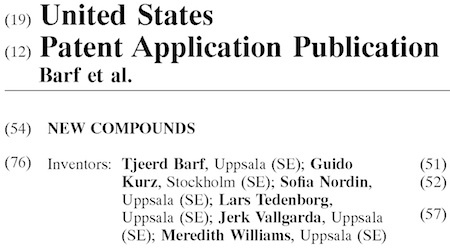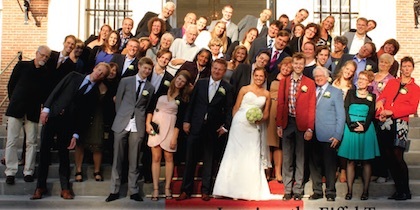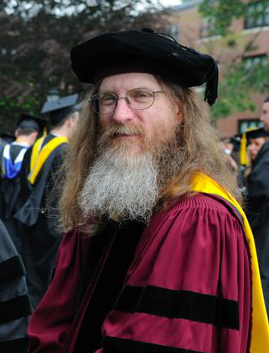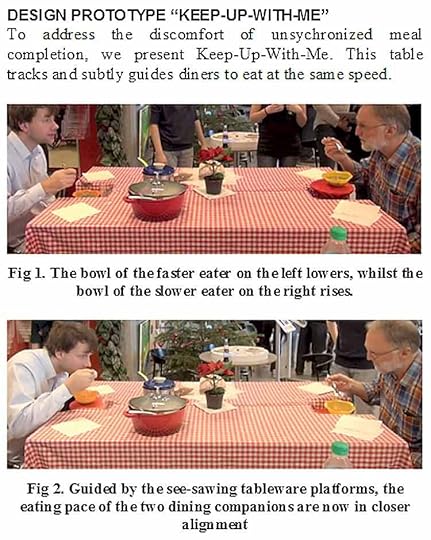Marc Abrahams's Blog, page 304
October 4, 2015
Barf and Jerk’s new compounds
Some years ago Tjeerd Barf and Jerk Vallgarda, and three colleagues filed an application to patent some new compounds:
“New compounds,” Tjeerd Barf, Guido Kurz, Sofia Nordin, Lars Tedenborg, Jerk Vallgarda, and Meredith Williams, U.S. Patent Application 11/050,178, filed February 3, 2005.

(Thanks to investigator Cristina Ekstrom for bringing this to our attention.)

October 3, 2015
The Snoezelen/Dementia Disco/Nursing-Home Question
A medical controversy, little reported, about snoezelen:
“Snoezelen in Dementia: Disco in the Nursing Home or Sensible Therapeutic Offering?” [article in German], Reuschenbach B, Mallau A., Pflege Zeitschrift, 2005 May;58(5):304-8. The authors are at the Psychologischen Institut, Abt. Allgemeine & Theoretische Psychologie, Universität Heidelberg.

October 2, 2015
Animal squawks squeaks and songs (with helium)
 Although a considerable body of scholarly work has examined the effects of Helium (2He) on human voice production [see, for example (Helium-assisted) High note research] we are by no means the only animals to have been investigated in this respect – here is a (non-exhaustive) list of examples of other creatures who have squawked, croaked, squeaked and even sung (soprano) under the influence of 2He.
Although a considerable body of scholarly work has examined the effects of Helium (2He) on human voice production [see, for example (Helium-assisted) High note research] we are by no means the only animals to have been investigated in this respect – here is a (non-exhaustive) list of examples of other creatures who have squawked, croaked, squeaked and even sung (soprano) under the influence of 2He.
Frogs: Frogs in helium: The anuran vocal sac is not a cavity resonator.
Bats: The acoustics of the vocal tract in the horseshoe bat Rhinolophus hildebrandti.
Dolphins: Dolphin whistles: a functional misnomer revealed by heliox breathing.
BONUS with audio: ‘Soprano singing in gibbons’ – their normal singing can be heard here, via the Silvery Gibbon Project, and their Helium Soprano voice, here, via Nature.
Note: The photo shows Sir William Ramsay KCB FRS FRSE (1852–1916) the British chemist who received the 1904 Nobel Prize in Chemistry for his work on the ‘Noble Gases’ e.g. 2He

October 1, 2015
Biometrics via armpit odo(u)r assessment (w & w/o deodorant)
In these days of intensified focus on accurate biometrics, the question may be asked: ‘Is it possible to ID an individual by their armpit odour – even if they use deodorant?’
Researchers Chatchawal Wongchoosuk, Mario Lutz and Teerakiat Kerdcharoen from Mahidol University, Bangkok, have made preliminary progress in this field. Their paper ‘Detection and Classification of Human Body Odor Using an Electronic Nose’ (in: Sensors, vol. 9, pp. 7234-7249) recounts the development of their E-nose which features enhanced humidity correction.
“Armpit odors of two volunteer persons were measured by an E-nose during five days using a combined hardware/software humidity correction.“
“During the experiment period, the volunteers were requested to go about their ordinary life and activities: for example, they took a shower twice a day (before going to bed and after waking up following the morning sample collection). To avoid fluctuation in odor samples, they were not allowed to have sex and/or consume alcohol. To study the effects from deodorant, the volunteers were requested to use deodorant, after taking shower in the morning, but only on the right arm.”
The results, for those who wish to open the door to the field of human body odor biometrics, were promising :
“The E-nose in conjunction with PCA [principle component analysis] method was shown to differentiate the body odors of two persons with similar life style and activities. In addition, we have found that deodorant does not effect the relative identification of these two persons. In order to extend the discrimination of human body odors beyond two persons, a number of improvements are required such as increasing sensor types that response to a variety of volatile molecules. It is hoped that the preliminary results presented in this paper will open the door to the field of human body odor biometrics.”

September 30, 2015
Podcast #31: Tilted Eiffel Tower, Green-haired Swedish Blondes
Leaning to the left makes the Eiffel Tower seem smaller; Converting old Russian ammunition into new diamonds; A machine that you can point at someone to induce them to get confused, and shut up; How to see brain activity in a dead salmon; and The puzzle of why some blonde people in Sweden suddenly found their hair turning green— all these all turn up in this week’s Improbable Research podcast.
Click on the “Venetian blinds” icon — at the lower right corner here — to select whichever week’s episode you want to hear:
SUBSCRIBE on Play.it, iTunes, or Spotify to get a new episode every week, free.
This week, Marc Abrahams tells about:
Some of the things that won Ig Nobel Prizes in 2012. (“Leaning to the Left Makes the Eiffel Tower Seem Smaller: Posture-Modulated Estimation,” Anita Eerland, Tulio M. Guadalupe and Rolf A. Zwaan, Psychological Science, vol. 22 no. 12, December 2011, pp. 1511-14.
 / The SKN Company / “SpeechJammer: A System Utilizing Artificial Speech Disturbance with Delayed Auditory Feedback“, Kazutaka Kurihara, Koji Tsukada, arxiv.org/abs/1202.6106. February 28, 2012. / “Neural correlates of interspecies perspective taking in the post-mortem Atlantic Salmon: An argument for multiple comparisons correction,” Craig M. Bennett, Abigail A. Baird, Michael B. Miller, and George L. Wolford, poster, 15th Annual Meeting of the Organization for Human Brain Mapping, San Francisco, CA, June 2009. It was later published as: “Neural Correlates of Interspecies Perspective Taking in the Post-Mortem Atlantic Salmon: An Argument For Multiple Comparisons Correction,” Craig M. Bennett, Abigail A. Baird, Michael B. Miller, and George L. Wolford, Journal of Serendipitous and Unexpected Results, vol. 1, no. 1, 2010, pp. 1-5. / Johan Pettersson and the mystery of the green-haired blondes. Featuring a dramatic reading by Jean Berko Gleason
.
)
/ The SKN Company / “SpeechJammer: A System Utilizing Artificial Speech Disturbance with Delayed Auditory Feedback“, Kazutaka Kurihara, Koji Tsukada, arxiv.org/abs/1202.6106. February 28, 2012. / “Neural correlates of interspecies perspective taking in the post-mortem Atlantic Salmon: An argument for multiple comparisons correction,” Craig M. Bennett, Abigail A. Baird, Michael B. Miller, and George L. Wolford, poster, 15th Annual Meeting of the Organization for Human Brain Mapping, San Francisco, CA, June 2009. It was later published as: “Neural Correlates of Interspecies Perspective Taking in the Post-Mortem Atlantic Salmon: An Argument For Multiple Comparisons Correction,” Craig M. Bennett, Abigail A. Baird, Michael B. Miller, and George L. Wolford, Journal of Serendipitous and Unexpected Results, vol. 1, no. 1, 2010, pp. 1-5. / Johan Pettersson and the mystery of the green-haired blondes. Featuring a dramatic reading by Jean Berko Gleason
.
)List of everything that won an Ig Nobel Prize in 2012.
The mysterious John Schedler or the shadowy Bruce Petschek perhaps did the sound engineering this week.
The Improbable Research podcast is all about research that makes people LAUGH, then THINK — real research, about anything and everything, from everywhere —research that may be good or bad, important or trivial, valuable or worthless. CBS distributes it, both on the new CBS Play.it web site, and on iTunes and Spotify).

Valerio Molinari joins Luxuriant Flowing Hair Club for Scientists (LFHCfS)
Valerio Molinari has joined the Luxuriant Flowing Hair Club for Scientists (LFHCfS). He says:
I am a Chemist working in Max Planck Institute of Colloids and Interfaces (Potsdam, Germany). My dream is to synthesize a new conditioner efficient for my hair — a project still not accomplished, as you can see.
Valerio Molinari, LFHCfS
Doctoral student in chemistry
Max Planck Institute of Colloids and Interfaces
Potsdam, Germany


September 29, 2015
Three cases of discomforting hair in funny places
Further examples of the occasional medical drawbacks of facial hair and of haircuts:
“Facial fuzz and funny findings — Facial hair causing otalgia and oropharyngeal pain,” Francis A. Papay [pictured here], Howard L. Levine, and William A. Schiavone, Cleveland Clinic Journal of Medicine, vol. 56, no. 3, 1989, pp. 273-276. The authors report:
“Three patients with referred otalgia and/or oropharyngeal pain due to ectopic facial hair found in either the external auditory canal or oropharynx were treated at the Cleveland Clinic Foundation, Department of Otolaryngology and Communicative Disorders. In each of these patients, annoying symptoms were relieved by simple removal of the misplaced facial hair.”
Here’s illustrative detail from the study:

September 28, 2015
Oliver Vikbladh joins Luxuriant Flowing Hair Club for Scientists (LFHCfS)
Oliver Vikbladh has joined the Luxuriant Flowing Hair Club for Scientists (LFHCfS), has now gained membership also in the Luxuriant Facial Hair Club for Scientists (LFHCfS). Jan Zimmermann, who nominated him, says:
Oliver Vikbladh is an extraordinary creature, and his flowing hair inspires the entire Center for Neural Science at New York University.
Oliver Vikbladh, LFHCfS
Graduate student
Center for Neural Science
New York University
New York, New York, USA


LFHCfS member Richard Rees Joins LFHCfS
Richard Rees, a longtime member of the Luxuriant Flowing Hair Club for Scientists (LFHCfS), has now gained membership also in the Luxuriant Facial Hair Club for Scientists (LFHCfS). He says:
I have long been a member of the The Luxuriant Flowing Hair Club for Scientists, having joined in 2001-2003 (I am on the first membership page). Since I have been a member for so long, my profile is now out of date, and I would appreciate it if it could be updated. Here is a more recent picture, and my profile should be updated as follows:
I am now a full professor, not an assistant professor. My institution’s name is now Westfield State University (it got promoted too!) My department is now called the Department of Chemical and Physical Sciences. As you can tell from the new picture, I think I am also eligible to be a member of the Luxuriant Facial Hair Club for Scientists.
Richard Rees, Ph.D, LFHCfS
Professor
Department of Chemical and Physical Sciences
Westfield State University
Westfield, Massachusetts, USA


Boer’s Lively Dining Table and Toilet Brush
“Sharing a mealtime, but not truly eating together can cause social friction and discomfort. For instance, being closely observed whilst eating can feel awkward and disrespectful. The person who is last to finish the food may suffer the discomfort of being watched by their no longer actually eating dining companions.”
What, if anything, might be done? For answers, see the work of ethnographic provocation specialist Professor Laurens Boer (at the Mads Clausen Institute, University of Southern Denmark) who, along with colleagues Robb Mitchell, Alexandra Papadimitriou and Youran You, has worked on the development of a ‘Keep-Up-With-Me’ dining table :
“This mechatronical table incorporates a mechanism to gauge the relative weight of food on the dishes of dining partners. Actuators gradually raise the dish of a slower eating partner, and lower the dish of a faster eater by a corresponding amount. These discrete signals may iteratively bring the eating pace of dining companions back into mutual alignment.”
See: ‘Really eating together: a kinetic table to synchronise social dining experiences’ in: AH ’15 Proceedings of the 6th Augmented Human International Conference, March 2015, Singapore, pp. 173-174.
For another example of the professor’s ethnographic provocations, also see ‘The Toilet Companion’ – an augmented toilet brush, which aims to provide moments of joy in the toilet room.
“Based upon the amount of time a user sits upon the toilet seat, the brush swings it handle with increasing speed: initially to draw attention to its presence, but over time to give a playful impression. Hereafter, the entire brush makes rapid up and downward movements to persuade the user to pick it up. In use, it generates beeps in response to human handling, to provide a sense of reward and accompanying pleasure.“
‘The toilet companion: a toilet brush that should be there for you and not for others’ (also from AH’15)
Question: Improbable seems to recall accounts of an artist who built a dining table that, over the course of the meal, swapped around the location of every seat, so that people got to spend part of the meal seated next to each other person at the table – but now we can’t find any reference to it. Can any readers assist?

Marc Abrahams's Blog
- Marc Abrahams's profile
- 14 followers






